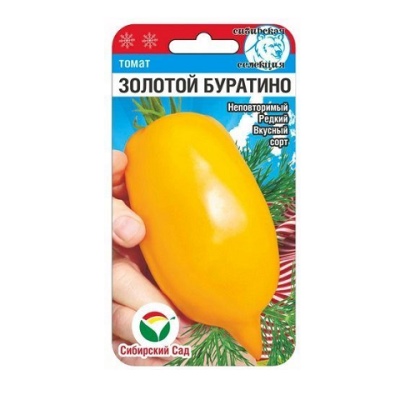
- Category: grade
- Appointment: fresh consumption, for pickling and preserving
- Ripening period: mid-season
- Ripening time, days: 110
- Growing conditions: for closed ground
- Marketability: high
- Transportability: Yes
- Bush height, cm: up to 180
- Bush characteristic: poorly developed
- Foliage: weak
Golden Pinocchio is an amazing variety of tomatoes with unique taste. If you are an inexperienced grower, it is worth trying to grow it on the site, since it is not too demanding to care for.
Description of the variety
Varietal plant Zolotoy Buratino is suitable for planting indoors. The maximum height of the bushes is 180 cm. The plants are underdeveloped, the foliage is small.
The fruits are of high marketability and excellent transportability.
The main qualities of the fruit
When ripe, Golden Pinocchio is yellow, the fruits are large, with a maximum weight of up to 400 grams.
Up to 8 ovaries are formed in one cluster, up to 6 can grow on the stem of such tassels. The fruits of the Golden Pinocchio are not subject to cracking.
Taste characteristics
It tastes sweet. The fruit is good fresh and suitable for canning. This variety is especially appreciated for its tender pulp that melts in the mouth.
Ripening and fruiting
Mid-season Golden Pinocchio ripens in 110 days.
Yield
The variety is fruitful with a fruit yield of 12-14 kg / sq. m.
The timing of planting seedlings and planting in the ground
The seeds can be planted in March-April. Seedlings are transferred to closed ground when up to 6 main leaves have already formed on the bushes.

Growing tomato seedlings is an extremely important process, because it largely depends on whether the gardener will be able to harvest at all. All aspects must be taken into account, from seedbed preparation to planting in the ground.
Landing scheme
The ideal solution is 40x60 cm as it fits most tomatoes.

Growing and care
To avoid thinning of seedlings, to reduce the cost of seeds, the seed of this variety is pelleted. The pelleted seeds are 6-8 times larger than ordinary seeds, so they can be sown evenly over the area. Seedlings obtained in this way develop rapidly, and the yield of Golden Pinocchio tomatoes increases. For pelleting, peat is used, which has a slightly acidic or neutral reaction (pH 6.5-7). Particle size 0.20-0.25 mm. Powdered superphosphate is added, ground to particles 0.15-0.25 mm, at the rate of 15-20 g per 1 kg of dry peat. An 8-10% solution of bentonite clay or 0.05% polyacrylamide solution, 1.5% pectin glue or 2% starch paste are used as a sticky substance. 1-1.2 g of ammonium nitrate and 1.2-1.5 g of potassium sulfate and microelements, mg: manganese sulfates 40, copper 10, boric acid 40 are added per 1 liter of adhesive solution. 6-7 kg of dry mix 4-5 liters of adhesive solution.
The seeds are soaked and germinated at a temperature of 18-20 degrees. They will swell in 24-36 hours.After that, they are spread in a thin layer, covered with burlap and kept at a temperature of 18-20 degrees until germination begins. The germinated are aired and sown in moist soil.
Seedlings of Golden Pinocchio are mainly grown without picking. Seeds are sown in the soil of greenhouses equipped with an air heating system. The soil is prepared in autumn: the remains of plants are removed, disinfected, deep loosening is carried out, the area is treated with "Carbation".
Organic fertilizers are applied at the rate of 30% by volume per 10 cm layer: humus - 27 kg, peat - 9-10 kg per 1 m2.
Fertilizers are covered to a depth of 10 cm. The introduction of humus can be replaced with 1.2 kg of straw.
Greenhouses are covered with foil 2-3 weeks before sowing seeds. 3-4 days before sowing, mineral fertilizers are applied to the soil, g / m2: ammonium nitrate 25-30, superphosphate - 50-60, potassium sulfate - 15-20. After the emergence of seedlings, the seedlings of Golden Pinocchio are kept (hardened) for 4-7 days at a temperature of 7-9 at night and +15 degrees in the daytime. Planting seedlings is possible at an average air temperature of 14-15, in sunny weather - 21-23 and in cloudy weather - 17-19 degrees Celsius. During this period, the humidity should be at the level of 55-60%.




A plant needs different micronutrients at each stage of growth. All fertilizers can be divided into two groups: mineral and organic. Folk remedies are often used: iodine, yeast, bird droppings, eggshells.
It is important to observe the rate and period of feeding. This also applies to folk remedies and organic fertilizers.



























































































